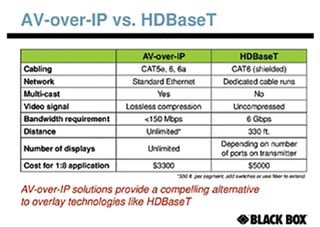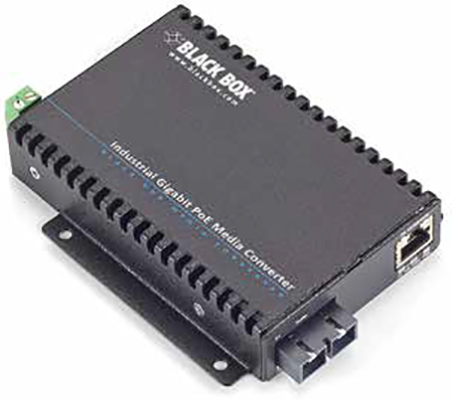Analog video distribution systems have several vulnerabilities regarding quality and distance, not least of which is that analog technology is being phased out in favor of higher quality digital equipment. The biggest challenge with digital signal distribution has been its need for a large amount of bandwidth. Now you can break free from traditional video limits by deploying HD video over your IP network. Image quality remains excellent, and costs are minimal because setup uses infrastructure already in place.
Scalability and flexibility
Using an IP-based video distribution platform provides a whole new level of scalability compared to existing proprietary and coax systems. Distribution and extension of the video signals are achieved by sending packetized video through standard local area network (LAN) equipment with existing CAT5e or CAT6 network cabling. Any number of displays located anywhere in the building can receive video content through connection to the LAN.
Furthermore, an IP-based solution has no distance limitations. Although standard Ethernet segments are limited to 330 feet, switches or repeaters can be added to get additional distance. For very long runs, runs between buildings, or in installations in industrial environments with high levels of EMI, standard Ethernet media converters can be used with the system to convert the electrical signals into optical ones for transport over fiber cable.
One of the biggest challenges with any traditional video distribution solution is that a splitter has a fixed number of ports, which limits the number of displays supported. Additionally, extenders might be required to reach out to remote displays. Proprietary video cables, such as HDMI, have distance limitations and were not designed to be terminated in the field, and the large form factor of the connector makes it a huge challenge to pull these cables through conduits and walls.
Image quality
MPEG compression works well to deliver low to medium quality over very limited bandwidth (Kbps to Mbps), but is not suitable for high-quality computer graphics. Using efficient compression algorithms and higher bandwidth (100–150 Mbps) makes it possible to run full HD, real-time video over the local network without loss of video quality
Installation
Installation is simplified when the HD video transmitter and receiver can be powered over Ethernet as well. A standard PoE-compliant network switch is able to distribute the video signals and power any transmitter or receiver unit connected to the switch. This greatly reduces the time required for installation and potentially avoids the use of expensive electricians for running additional power outlets. A PoE-based solution also provides improved reliability since low cost external power supplies are proven to be the first thing that fails in most AV installations.

Unicast, multicast, & video walls
Point-to-point unicasting is supported by standard gigabit Ethernet switches and can be used for single-receiver distribution. Multicasting, which is sending data over a network from one transmitter to multiple receivers, calls for a switch with IGMP support. IGMP snooping switches parse intended receivers from the network; instead of needing to send the video to every receiver, IGMP queriers know which devices on the network want to receive the packet and which don’t. This saves the network from being overwhelmed with broadcast traffic.
Sending high-quality images and video over a LAN has never been more advantageous. It’s cost-effective, easy to implement, flexible and scalable, and has no distance limitations.
Courtesy: www.blackbox.com










